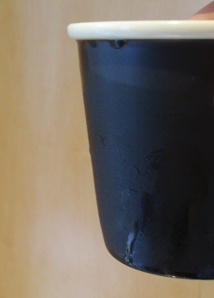You are currently browsing the tag archive for the ‘CO2’ tag.
Following on from our ‘lava lamp‘ we did a variation of the chemical reaction involved, that shows how the carbon dioxide (CO2) is heavier than air. The density is approx. 1.98 kg/m3, whereas air is only 1.2 kg/m3.
We placed a small cup in a deep dish and put a short burning candle in next to it. In the cup we put about 2 tsps each of
- sodium bicarbonate, aka baking soda (NaHCO3)
- citric acid (C6H8O7)
Then we added some water (H2O).
The chemical equation for this is
3 NaHCO3 + C6H8O7 –> 3 CO2 + 3 H2O + Na3C6H5O7
You see the mixture bubbling from the production of CO2, but you can’t see the CO2 itself. However, because it is dense, the CO2 spills over the top of the cup and collects in the dish below. When it is deep enough, it puts out the candle.
We also put several lighted matches down into the space at the bottom of the dish, and they went out too. This was quite an impressive effect for quite small amounts of chemical.
Here is how it looked:
Another noticeable effect is that the reaction is endothermic, it absorbs energy (heat), and therefore cools down. So the mixture left in the cup is much colder than what we started with. It was very noticeable to the touch, and you could see condensation on the cup as well. So, clearly we need to obtain a thermometer suitable for this kind of investigation.
Although mixing baking soda and vinegar produce CO2 as well, the mixture tends to foam. That means that the CO2 is released into the air more gradually, since the foam has to dissipate before the bubbles are released.




